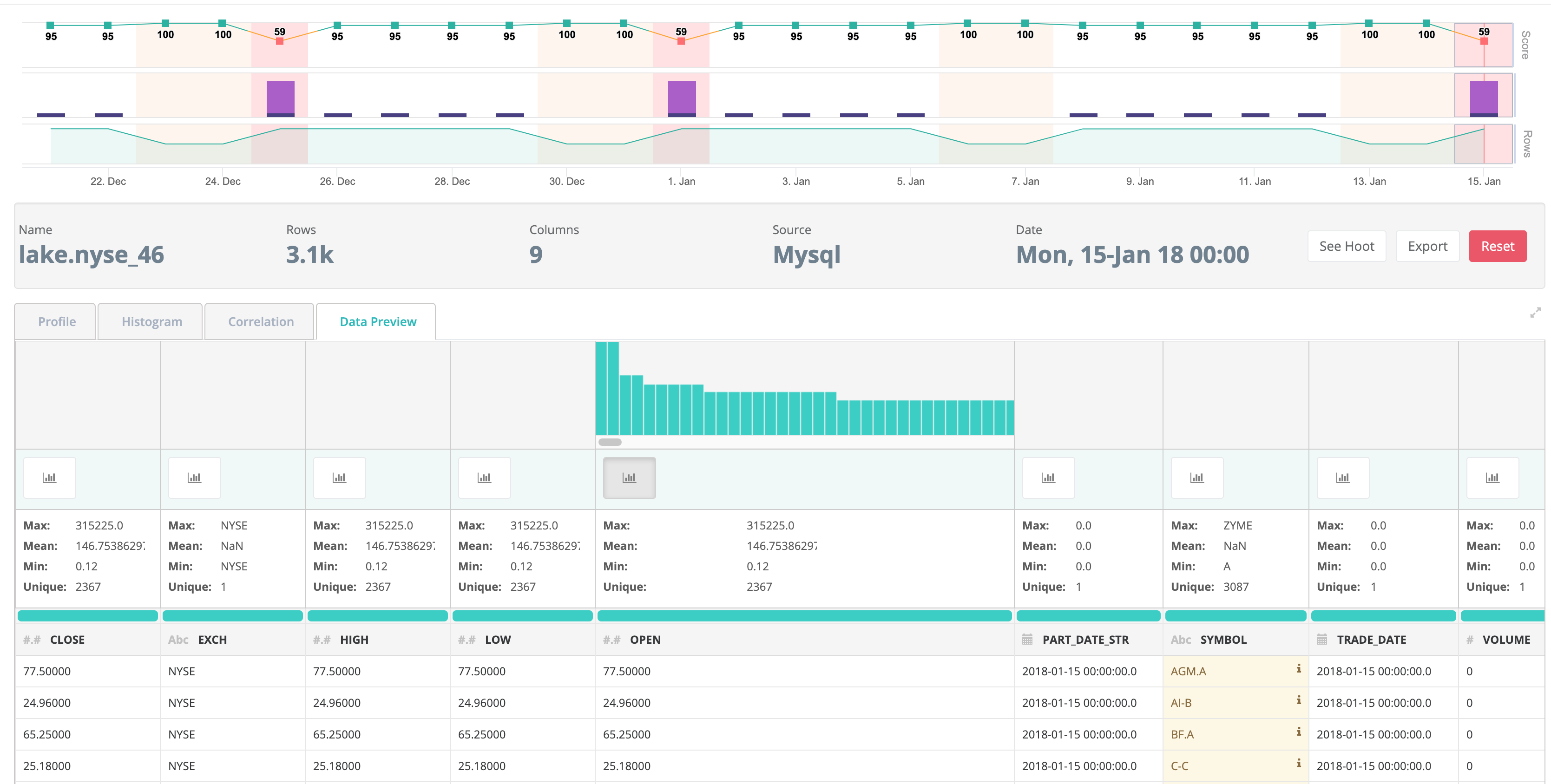Simple
Load Table use SparkJDBC
//--- Configure Table From Database ---//
val connProps = Map (
"driver" -> "org.postgresql.Driver",
"user" -> s"${user}",
"password" -> s"${pass}",
"url" -> s"jdbc:postgresql://${host}:${port}/${database}",
"dbtable" -> "cdq_test.nyse"
)
//--- Load Spark DataFrame ---//
val jdbcDF = spark.read.format("jdbc").options(connProps).load
jdbcDF.show
Connect to DQ's Metadata Database and control DQ scan options. Wrap sparkDF with DQ context.
import com.owl.common.options._
import com.owl.core.util.OwlUtils
val opt = new OwlOptions
//--- Collibra DQ Metastore ---//
opt.host = s"$cdqHost"
opt.port = s"xxxx/postgres?currentSchema=public"
opt.pgUser = s"$cdqUser"
opt.pgPassword = s"$cdqPass"
//--- Run Options ---//
opt.dataset = "cdq_test.nyse"
opt.runId = "2018-01-10"
opt.datasetSafeOff = true
val cdq = OwlUtils.OwlContext(jdbcDF, opt)Register with Catalog and Run Profile
//--- Register with Collibra DQ Catalog ---//
cdq.register(opt)
cdq.owlCheck()
//--- Profile Dataset ---//
val profile = cdq.profileDF
profile.showNotice that DQ returns results as Dataframes. This is a fantastic abstraction that allows you to ignore all domain objects and custom types and interact with a scaleable generic result set using common protocols like "where" or "filter" or "save" or "write" all with parallel operations.
+--------------+-----+-------+-----------+---+---+--------+-----------+------+----+------+-------+-------+------+----+---------+
| column|nulls|empties|cardinality|min|max|is_mixed|mixed_ratio| Int|Long|String|Decimal|Boolean|Double|Date|Timestamp|
+--------------+-----+-------+-----------+---+---+--------+-----------+------+----+------+-------+-------+------+----+---------+
| tenant_id| 0| 0| 60| 0| 9| false| 0.0|100000| 0| 0| 0| 0| 0| 0| 0|
| a11| 0| 0| 1|a11|a11| false| 0.0| 0| 0|100000| 0| 0| 0| 0| 0|
| a10| 0| 0| 1|a10|a10| false| 0.0| 0| 0|100000| 0| 0| 0| 0| 0|
| account_type| 0| 0| 3| 02| 06| false| 0.0|100000| 0| 0| 0| 0| 0| 0| 0|
| a13| 0| 0| 1|a13|a13| false| 0.0| 0| 0|100000| 0| 0| 0| 0| 0|
|security_alias| 0| 0| 3| 0| 2| false| 0.0|100000| 0| 0| 0| 0| 0| 0| 0|
| a12| 0| 0| 1|a12|a12| false| 0.0| 0| 0|100000| 0| 0| 0| 0| 0|
+--------------+-----+-------+-----------+---+---+--------+-----------+------+----+------+-------+-------+------+----+---------+Profile UI
While the spark DF.show() is a nice and convenient output format, you may prefer a rich UI visual that tracks the data tests over time. The UI provides trend analysis, data drift, data relationships and more.

Duplicates
Take duplicate detection for example. A common use case where a business wants to make sure they do not have repeated or duplicate records in a table. Set the lowerBound to the percent fuzzy match you are willing to accept, commonly 87% or higher is an interesting match. You might also want to target a single day or week or month that you shouldn't have dupes within. Notice the .where function and then pass in a custom dataframe to the DQ context.
opt.dupe.on = true
opt.dupe.lowerBound = 99
opt.dupe.include = Array("SYMBOL", "EXCH")
val df1Day = jdbcDF.where("TRADE_DATE = '2018-01-10' ")
val cdq = OwlUtils.OwlContext(df1Day, opt)
cdq.owlCheck()
val dupesPreview = cdq.getDupesPreview()
val records = cdq.getRecordsDF
dupes.show
// rdd collect
dupes.rdd.collect.foreach(println)
// records linked together for remediation
cdq.getDupeRecords.showOutliers
Gaining and understanding of your outliers is a commonly desired DQ function. DQ has several configurations to help find the most meaningful outliers in your dataset and over time. Below compares the current day to a baseline of days in the historical dataframe.
val outlierOpt = new OutlierOpt()
outlierOpt.combine = true
outlierOpt.dateColumn = "trade_date"
outlierOpt.lookback = 4
outlierOpt.key = Array("symbol")
outlierOpt.timeBin = OutlierOpt.TimeBin.DAY
outlierOpt.historyLimit = 10
dlMulti.add(outlierOpt)
opt.setOutliers(dlMulti)
val cdq = OwlUtils.OwlContext(df, opt)
.register (opt)
cdq.setHistoricalDF(dfHistory)
cdq.owlCheck()
val outliers = cdq.getOutliers()
outliers.show